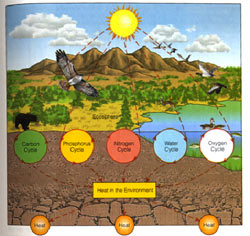Breaking News:
Whole Foods Market Receives First Zero Waste Certificates
CORONA DEL MAR, March 4, 2013- The U.S. Zero Waste Business Council (USZWBC) announced today that it is launching the first Zero Waste business certification program in the country. The announcement coincides with the organization's issuance of the first Zero Waste certifications to three Whole Foods Market stores in San Diego County. Go to the Press Release
Zero Waste: Ecology Applied to Materials Cycling
A five billion year-old lesson. Waiting to be discovered by modern man.
Bill McDonough, co-author of Cradle-to-Cradle And “Being Less Bad Is Not Being Good”, puts it this way: “There are two fundamental frameworks for metabolism: biological and technical nutrients. So we ask a company, are your materials safe and healthy for human and ecological systems? Do you have reverse logistics- do we know where this stuff comes from, where it goes, and how to get it back and it onto closed, zero-waste cycles?”
If we can't reuse it, recycle it or compost it, industry shouldn't be making it. To even begin to approach zero waste- whether that's 90% diversion or more- we need better industrial design for this 21st Century.
Edutainment
If we want to live sustainably, we need zero waste design for business and industry. Learn about what this means in theory and practice:
Tom Wright on Zero Waste with Bill Roth
Original file location:.http://youtu.be/sNE4fdiBSdo |
William McDonough introduces the concept of Cradle to Cradle
Original file location: http://youtu.be/o7ZU3MJJvV8 |
.
Ray Anderson on TED Talks
Original file location:.http://www.ted.com/talks/ray_anderson_on_the_business_logic_of_sustainability.html |
Q: Will Extended Producer Responsibility (EPR) move everything toward the Zero Waste Paradigm?
A: Read the artticle from NCRA News, October 2011
- by Tom Wright, SustainableBizness.com
Extended Producer Responsibility (EPR) is the extension of the responsibility of producers for the environmental impacts of their products and packaging for the entire product life cycle - especially for the take-back, recycling and composting of these products, as well as the potential disposal of toxic substances. EPR is based on the 'polluter pays' principle. The simple idea is to get true-costs into the product, so that the market responds authentically and recovery of the resource becomes more probable.. more
Buckminster Fuller, 1981
-
"The success of all humanity can be accomplished only by a terrestrially comprehensive technologically competent, design revolution...
This revolution must develop artifacts whose energy-use efficiency not only occasions the artifacts' spontaneous adoption by humanity, but therewith also occasions the inadvertent, unregretted abandonment and permanent obsolescence of socially and economically undesirable viewpoints, customs, and practices."
- R. Buckminster Fuller, Critical Path, pg. 199"
Peter Senge, The Necessary Revolution
Peter Senge’s book, The Necessary Revolution, reviews the issues around sustainable development. It provides examples of how companies are taking a proactive approach to protect themselves and society from the alternatives- the inevitable result of complacency
We are exiting the “Industrial Age” and entering a new one- one characterized by the need for a triple bottom line, where social and natural capital are also accounted for.
We must operate within the limits imposed by the renewable resources of Nature, and not extract and waste beyond the ability of the earth to sustain its living biosphere.
Nature and society are a system, and alas, we are a part of the living system.Materials Matter
In the book Materials Matter (2001), author Kenneth Geiser, explains the relevance of handling materials in systems approach.
“ From an environmental perspective, materials do matter. Some materials are exceedingly hazardous to make and use and, once discarded, pollute and contaminate the environment, while other materials are made safely and degrade naturally once disposed.
Living in the Environment
From the must read text book, Living in the Environment, by G. Tyler Miller
What Sustains Life on Earth? Many biologists believe that the best way for us to live sustainably is to learn about the processes and adaptations by which nature sustains itself and mimic these lessons from nature. The precautionary principle suggests that we should prevent damage to the environment, even if some cause-and-effect relationships are not understood.
|
 |
"The primary output of today's production process is waste....
Across all industries, less that 10% of everything that is extracted from the Earth (by weight) becomes usable products. The remaining 90% to 95% becomes waste from production."
-Peter Senge and Goran Carstedt

